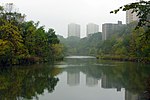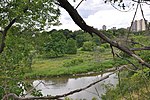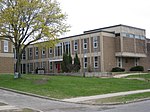Raymore Drive
1954 disasters in Canada1954 in Canada1954 in OntarioFloods in CanadaHistory of Toronto ... and 2 more
Hurricane HazelStreets in Toronto

Raymore Drive is a mostly residential street in the Weston neighbourhood of Toronto in the Canadian province of Ontario. It runs next to the Humber River. On October 15, 1954, the area was severely affected by Hurricane Hazel. When the Humber River burst its banks and tore away a footbridge, the waters of the Humber were redirected through the neighbourhood. The flood killed 35 residents and washed away 39 percent of the street. The washed-away part of Raymore Drive was never rebuilt, as subsequent residential development in that area has been prohibited; it is now part of Raymore Park. All together, Hazel was responsible for 81 deaths in Canada.
Excerpt from the Wikipedia article Raymore Drive (License: CC BY-SA 3.0, Authors, Images).Raymore Drive
Raymore Drive, Toronto Etobicoke
Geographical coordinates (GPS) Address Nearby Places Show on map
Geographical coordinates (GPS)
| Latitude | Longitude |
|---|---|
| N 43.69665 ° | E -79.515066666667 ° |
Address
Raymore Drive 95
M9N 1W2 Toronto, Etobicoke
Ontario, Canada
Open on Google Maps






